The Aran Islands lie in Galway Bay off the west coast of Ireland. They’re made up of Inis Mór, Inis Meáin, and Inis Oírr. People have likely lived on the islands since c. 3000 BCE. Late Bronze Age and Iron Age ruins scatter the islands, alongside old churches and holy wells.
After the era of saints and pilgrimages, Elizabeth I seized ownership of the islands in 1565 and in 1588, she sold them to the Lynch family. Oliver Cromwell took them back and passed them to his supporters. Absentee English landlords owned the islands until 1922.
They boast such fascinating sights as the Wormhole, believed to be the home of a giant serpent, and the remains of the ancient forts. The Aran Islands are also the home of the world-famous Aran sweaters!
Let’s find out more about saints, ancient forts, and knitting lore in this week’s article.
The Sunken Church of Inis Oírr
Teampall Chaomháin, or St. Caomhán’s church, dates to the 10th century. Known as the Sunken Church, the ruins are open to visitors. It looks like it’s been buried because sand drifted across the island over time. Eventually, the islanders excavated the ruins and they care for them now. It lies in the northeast of the island.
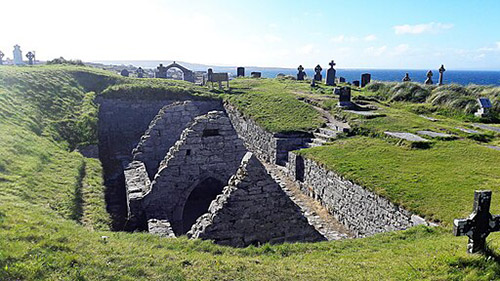
St. Caomhán is the patron saint of Inis Oírr. His grave lies near the church and is reputed to have curative powers. The saint is also the patron saint of the fishermen on the island. In years gone by, their families would cast white sand from his grave onto rough seas to ensure their loved ones came home safely (Passmore 2024).
Islanders celebrate his feast day on June 14 with Mass at the church.
St Enda’s Holy Well
You’ll also find Tobar Éanna, St. Enda’s holy well, on Inis Oírr. According to folklore, it can offer healing to those who seek it. You need to recite the Rosary as you walk around the well seven times. Then, look into the well and if you see an eel, you’ll be cured (Passmore 2024).
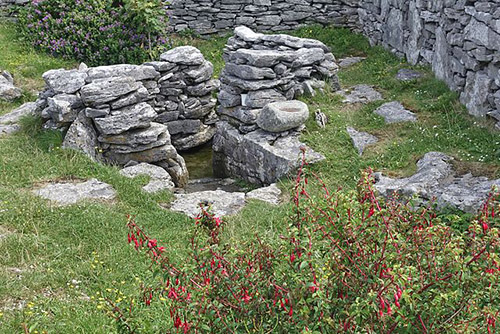
Originally a warrior, St Enda converted to Christianity and founded a monastery on Inis Mór in c. 1490. His feast day is 21 March. According to legend, he often prayed in the woods near Barna, and the well sprang up on the site. It was believed to work best for ear and eye ailments (Kenny 2022).
This appearance of a creature in the well to let you know the healing would work also appears in Wales. Two sacred fish lived in St Peris’ well near Llanberis. People either bathed the afflicted limb in the water or drink it. If the fish appeared, the cure would work. If the fish stayed hidden, the ailment would remain (Gary 2022: 26).
Another legend involves St Enda and St Bhreacáin. As the story went, they argued over land on Inis Mór. To best divide it between them, they agreed to say Mass at a given time at opposite ends of the island. Once they’d done this, they would walk towards the centre. Their meeting point would create the boundaries for their lands. St Bhreacáin cheated and started his Mass early. Somehow, St Enda found out and prayed for divine intervention. St Bhreacáin got his feet stuck in the sand, so most of the island fell to St Enda (Kenny 2022).
The Ancient Fort of Dún Aonghasa
The Iron Age fort, Dún Aonghasa, lies on the largest of the Aran Islands, Inis Mór. According to a legend in Lebor Gabála (Book of Invasions), the Fir Bolgs built it in the first century CE, naming it after Aenghus, their chief. They arrived on the island having fled from a defeat in battle with the Tuatha Dé Danann (Dalton 1928: 54).
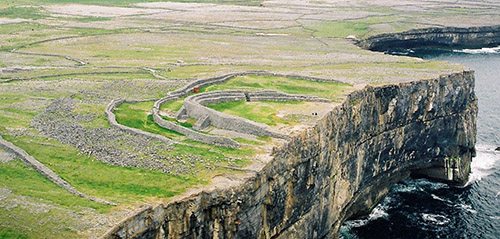
19th-century writers like John O’Flaherty believed the site to contain altars, stone pillars, and temples used by druids (1825: 97). In 1911, W.Y. Evans-Wentz claimed the site once housed an Aengus Cult (1911: 416), though it’s best to question those comments since they’re based on conjecture. As Morgan Daimler points out, Evans-Wentz wrote at a time when scholars could voice theories without evidence, and it can be difficult to separate fact from opinion (2020). Evans-Wentz conflates the semi-circular shape of the fort with a sun-temple, though he does admit that the fort may also have provided refuge in a practical sense (1911: 417).
But what is cool about Dún Aonghasa is that while there are around fifty Iron Age hill forts in Ireland (that have been identified, at least), archaeological evidence shows human occupation at the Dún Aonghasa site in the Late Bronze Age (Cotter 1994: 28). Important finds include clay moulds used to cast bronze items.
Claire Cotter explains that there are features in and around the fort, such as a bedrock platform at the cliff edge, that are not entirely natural, but there’s no way to know what the builders had in mind when they included them (1994: 27).
Witchcraft in the Islands
While much of the folklore I found seemed to involve the saints on the islands, I did find one anecdote from 1895 involving witchcraft.
Nathaniel Colgan was looking at plants on a beach at Killeany on Inis Mór when some locals warned him that handling the plants was a dangerous business. Colgan probed further, wondering if there were poisonous plants among the milk vetch he sought, yet found the concern stemmed from a very different quarter (1895: 84).
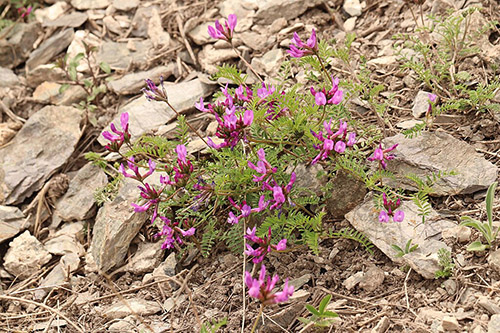
A local man explained that years previously, a friend fell ill and sought the services of a wise woman when the doctors could do nothing. Her method involved transferring sickness from the patient to a healthy ‘victim’, who would sicken in their place. She used plants to choose her victim, kneeling in a field near a road, picking a plant while looking at the first passerby she saw. This passerby would die of the sickness within 24 hours while the patient healed (Colgan 1895: 85).
Colgan notes that his informant knew the wise woman well, yet he’d only known her to use this method once, in the case of his friend. The man who ‘took’ his friend’s illness did indeed die (1895: 85). It seems the man couldn’t tell Colgan what plant she used, though his younger companions all scoffed at his story.
The Aran Sweater
There was no way I could include the Aran Islands and not mention Aran sweaters, or ‘geansaí’ in Irish (pronounced ‘gahnzee’). In the Geordie dialect, we also refer to jumpers as a gansey, so it’s likely we got that term from these sweaters! As you might know, I’ve been a keen knitter since 2007, and aran-weight yarn is probably my favourite to work with!
The Aran sweater is perfectly suited to the fishermen and farmers of the islands. According to Aran Sweater Market, one of the sweaters can absorb 30% of its weight in water before you feel wet. As they’re made of wool, they draw moisture away from the skin, and also trap air, helping to insulate the body (2024). It also helped that knitters used unscoured wool for the earliest sweaters, meaning the wool retained its lanolin, making the sweaters water-resistant (Paul 2024).
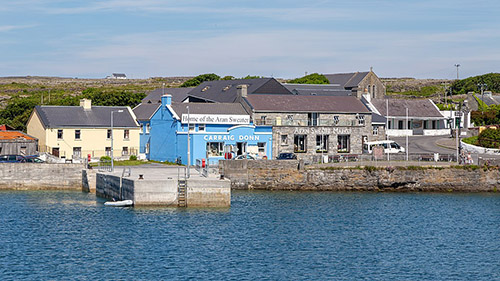
The sweaters can contain as many as 100,000 stitches, and the patterns vary between clans. The stitch patterns also represent imagery; the cable stitch represents ropes used by fishermen, while the diamond stitch represents the fishing net. The moss stitch represents the mossy soil (O’Maille 2024). A geansaí can have between four and six different texture patterns that run in columns down the front and back.
Paul at AranIslands.ie notes that no one really knows when people started knitting them. It’s likely that a group of women on the islands started making them in the early 20th century, both for their families and to sell (2024). Other sources suggest the sweaters are centuries old, especially since many stitch patterns mimic Celtic patterns or the patterns on megaliths. It’s a nice idea, but difficult to prove.
Patons of England published the first Aran patterns in the 1940s, and Vogue picked up the geansaí in the 1950s.
The Big Geansaí Myth
You might have heard the story that aran sweaters helped identify fishermen drowned at sea. According to this legend, the intricate patterns were specific to families, making identification possible. It sounds so plausible!
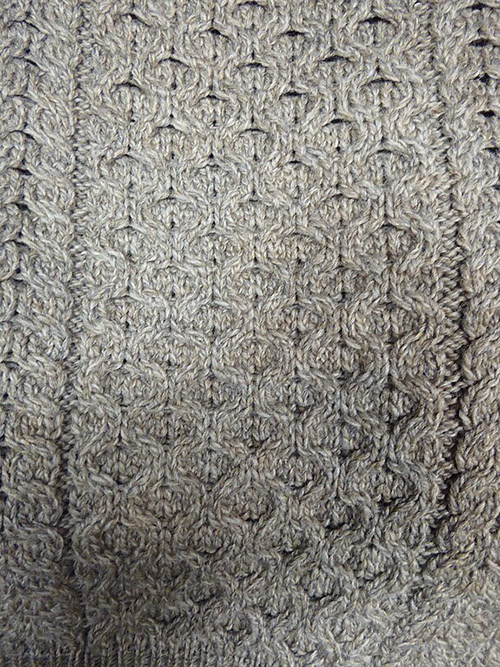
Yet as Paul at AranIslands.ie point out, there’s no evidence to support it. In fact, it’s likely that the idea came from ‘Riders to the Sea’, a 1904 play by J.M. Synge. In it, someone recognises the stitches on a handmade stocking, thus identifying a dead fisherman. The play certainly doesn’t mention a sweater or its ornamental pattern (2024).
There’s also no evidence that patterns were specific to families, either. So it’s likely that someone took the idea from the play and applied it to the sweaters. I desperately wanted that one to be true, and maybe there is evidence to support it, but no one has found it yet!
Visiting the Aran Islands
You can reach the islands using Aran Island Ferries all year round from Galway. Or you can fly from Connemara Airport. Get around the islands by hiring a bike and there are plenty of places to stay.
While you’re there, see if you can spot the filming locations for Banshees of Inisherin (2022), mostly filmed on Inis Mór!
Have you visited the Aran Islands? What did you make of them?
References
Aran Sweater Market (2024), ‘History of Aran Sweaters’, Aran Sweater Market, https://www.aran.com/history-of-aran-sweaters.
Colgan, Nathaniel (1895), ‘Witchcraft in the Aran Islands’, The Journal of the Royal Society of Antiquaries of Ireland, 5 (1), pp. 84–85.
Cotter, Claire (1994), ‘Atlantic Fortifications: The Duns of the Aran Islands’, Archaeology Ireland, 8 (1), pp. 24–28.
Daimler, Morgan (2020), ‘A Critical Look at Fairy Faith in Celtic Countries’, Living Liminally, https://lairbhan.blogspot.com/2020/02/a-critical-look-at-fairy-faith-in.html.
Dalton, John P. (1928), ‘Who Built Dun Aengus?’, Journal of the Galway Archaeological and Historical Society, 14 (1/2), pp. 52–77.
Evans-Wentz, W. Y. (1911), The Fairy-faith in Celtic Countries, London: H. Frowde. 416.
Gary, Gemma (2022), Wisht Waters: The Cult & Magic of Water, London: Troy Books.
Kenny, Tom (2022), ‘Tobar Éanna, St Enda’s Well, Barna Woods’, Galway Advertiser, https://www.advertiser.ie/galway/article/131150/tobar-anna-st-endas-well-barna-woods.
O’Maille (2024), ‘History of Aran Sweaters’, O’Maille, https://www.omaille.com/about/history-of-the-aran-sweater/.
O’Flaherty, John T. (1825), ‘A Sketch of the History and Antiquities of the Southern Islands of Aran, Lying off the West Coast of Ireland; with Observations on the Religion of the Celtic Nations, Pagan Monuments of the Early Irish, Druidic Rites, &c.’, The Transactions of the Royal Irish Academy, 14, pp. 97-98.
Paul (2024), ‘The Aran Sweater’, The Aran Islands, https://www.aranislands.ie/aran-islands/aran-islands-culture-history/the-aran-sweater.
Passmore, Patrick J. (2024), ‘Inis Oírr — Island of Cures and Healing Wells’, The National Catholic Register, https://www.ncregister.com/blog/inis-oirr.
Nutty about folklore and want more?
Add your email below and get these posts in your inbox every week.
You'll also get my 5-step guide to protecting your home using folklore!







Wow! Thank you for this amazing insight to a region rich in culture and lore. Isn’t it amazing to look back to our distant past when it was common to be connected to nature, legend and rituals that empowered!
Great post